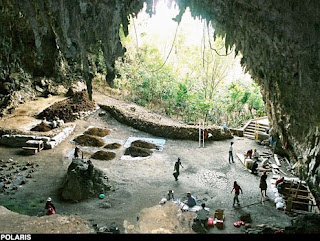(© Peter Brown)
The scientists, mainly from Australia's University of New England and University of Wollongong, have found the skeletal remains of up to seven individuals in a cave at Liang Bua, Flores. Their diminutive stature, small brain size (380 cc), receding chin, the shape of their first mandibular premolar tooth and the skull base design in the ear region are all reminiscent of early Australopithecus, a type of hominid which was thought to have existed only in Africa prior to 3 million years ago.
On the other hand the thickened cranial vault, the relatively flat face, and the smaller molar teeth of what is being called Homo floresiensis are all more reminiscent of Homo erectus, which flourished between 1.8 million and possibly 300,000 years ago.
The newly discovered Flores skeletal material, published this week in the scientific journal Nature, may be from a species which either b
roke away from our distant ancestor Australopithecus some 3 million years ago or more likely a species derived from a very early form of a later ancestor of ours, Homo erectus.
"The skeletal material we have found has come as a big surprise because hominids of that body size and brain size were supposed to have become extinct 3 million years ago," says excavation member Peter Brown, a physical anthropologist from the University of New England.
It is quite possible that the Homo floresiensis' tiny size--and correspondingly small brain--is a result of being stranded on a small island for tens or hundreds of thousands of years. Because species on small islands are shielded from predators living on mainland areas, large size often becomes redundant as an defensive advantage, and they "shrink" evolutionarily over time.
The archaeological evidence strongly suggests that H. floresiensis made sophisticated stone tools, including choppers, cutting blades, scrapers, and even spear points, some of which appear to have been hafted onto lengths of wood. Tools dating to 800,000 years ago have been found on Flores. These tools are very similar to those made by ordinary Stone Age humans (especially in Europe and North America), and yet the Flores hominid had a brain capacity similar--in terms of ratio to body size--to that of early humans like the australopithecines and Homo habilis, who made only very rudimentary stone tools. The only other explanation for the presence of such sophisticated stone tools, which were found together with the skeletal material, is that they were produced by Stone Age H. sapiens--but the earliest of the tools from this site date from 90,000 years ago and H. sapiens is not currently thought to have arrived in Southeast Asia until 50,000 to 60,000 years ago. In 1997, dates on fossils from Ngandong, Indonesia, suggested H. erectus survived as late as 53,000 to 27,000 years ago (see "Homo Erectus Survival").
"All the evidence so far indicates that the stone artifacts prior to 12,000 years ago at Liang Bua were all made by Homo floresiensis" says Mike Morwood, an archaeologist from the University of New England, who has been leading the investigations on Flores.
What's more, folklore evidence, which has been gathered by the researchers on the same island, provides the remarkable suggestion that H. floresiensis may have survived until at least 150 years ago. And zoological evidence from another Indonesian island, Sumatra, suggests that a potentially similar intelligent bipedal species may still be alive and well and living in a remote jungle area.
The local tradition for H. floresiensis is potentially significant. Villagers in Flores say that up until around 150 years ago, there were small, three-foot-tall hairy "people" who used to steal food from them. Known as the ebu gogos (literally "the grandmothers who eat anything"), they were tolerated by islanders until they stole a baby and ate it. Whether the ebu gogo is pure myth or an acc
urate recollection of H. floresiensis is at present unprovable. "The folklore material raises the real possibility that H. floresiensis actually survived until sometime in the nineteenth century," said excavation member Bert Roberts, a geochronologist at the University of Wollongong who conducted interviews with the villagers earlier this month. "Indeed, there has to be a remote possibility that they still survive today in some remote jungle area of the island."
Artist's rendering of the three-foot-high hominid (Peter Schouten/National Geographic Society)
The new discoveries are likely to be greeted with immense excitement by the international scientific community.
"We now have to entertain the possibility that somewhere within the islands of southeast Asia, early types of human being--long thought to have been extinct--may indeed still survive," says Robert Kruszynski, a leading anthropologist at the Natural History Museum in London.
David Keys is ARCHAEOLOGY's London correspondent.
Article Source :www.archaeology.org











0 comments:
Post a Comment